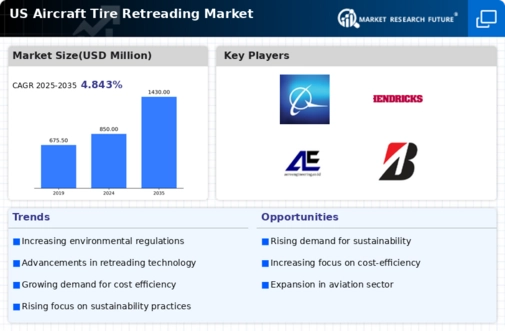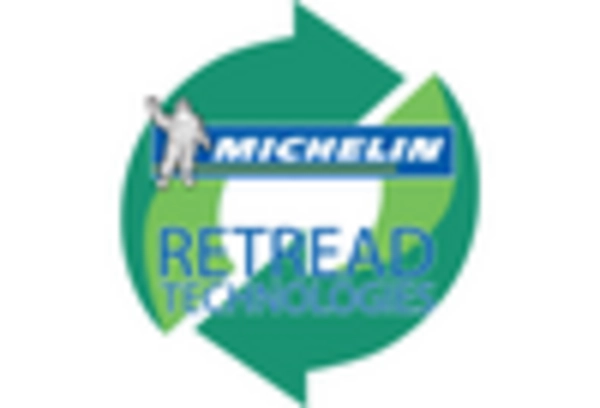Rising Demand for Air Travel
The aircraft tire-retreading market is poised for growth due to the rising demand for air travel in the United States. As passenger numbers increase, airlines are expanding their fleets and, consequently, their tire requirements. This surge in demand creates a corresponding need for tire maintenance solutions, including retreading. The aircraft tire-retreading market stands to benefit as airlines look for cost-effective ways to manage their tire inventories while ensuring safety and performance. With projections indicating a growth rate of approximately 5-7% in air travel over the next few years, the demand for retreaded tires is likely to rise, further solidifying the market's position within the aviation sector.
Cost Efficiency in Operations
The aircraft tire-retreading market is significantly driven by the need for cost efficiency in aviation operations. Airlines and operators are increasingly seeking ways to reduce operational costs, and retreading tires presents a viable solution. Retreading can lower tire costs by up to 30-50% compared to purchasing new tires, which is particularly appealing in a competitive market. This cost-saving potential encourages airlines to invest in retreading services, thereby boosting the aircraft tire-retreading market. Furthermore, as fuel prices fluctuate, the emphasis on reducing overall operational expenses becomes more pronounced, making retreading an attractive option for maintaining profitability. The aircraft tire-retreading market is thus positioned to benefit from this ongoing trend towards cost efficiency, as operators prioritize financial sustainability in their operations.
Increased Focus on Safety Standards
Safety standards in aviation are becoming increasingly stringent, which is a significant driver for the aircraft tire-retreading market. Airlines are mandated to adhere to rigorous safety protocols, and the quality of tires plays a crucial role in overall flight safety. Retreaded tires, when produced under strict quality controls, can meet or even exceed safety standards set by aviation authorities. This focus on safety encourages airlines to consider retreading as a reliable option, thereby enhancing the aircraft tire-retreading market. As safety regulations evolve, the market may witness a shift towards higher quality retreading processes, potentially leading to an increase in market share for retreading services as airlines prioritize safety alongside cost efficiency.
Environmental Regulations and Compliance
The aircraft tire-retreading market is influenced by stringent environmental regulations that govern waste management and sustainability practices in the aviation sector. As regulatory bodies impose stricter guidelines on waste disposal and emissions, airlines are compelled to adopt more sustainable practices. Retreading tires not only extends the life of the tires but also significantly reduces waste, aligning with environmental compliance requirements. The aircraft tire-retreading market is likely to see increased demand as airlines strive to meet these regulations while minimizing their environmental footprint. In fact, the market could expand as operators recognize the dual benefits of compliance and cost savings associated with retreading, which is often viewed as a more eco-friendly alternative to new tire production.
Technological Innovations in Retreading Processes
Technological advancements in retreading processes are a key driver for the aircraft tire-retreading market. Innovations such as improved materials, advanced curing techniques, and enhanced inspection technologies have led to higher quality retreaded tires. These advancements not only increase the safety and performance of retreaded tires but also extend their usable life, making them a more attractive option for airlines. The aircraft tire-retreading market is experiencing a shift as these technologies reduce the gap in performance between new and retreaded tires. As a result, airlines are more inclined to consider retreading as a viable alternative, potentially leading to a market growth of around 10-15% in the coming years as operators embrace these innovations.

















Leave a Comment